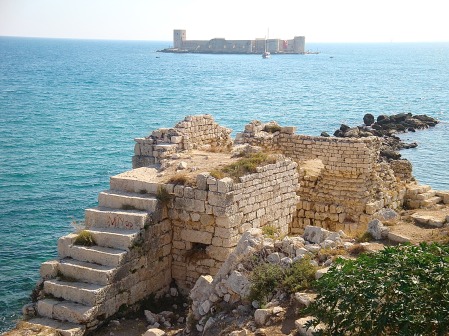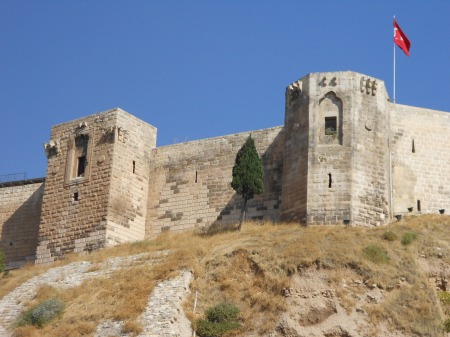Turkey is littered with the remains of battered castles that bear silent witness to Anatolia’s often turbulent past. Indeed there are parts of the country where almost every hilltop is crowned with shattered masonry, often placed there in defiance of any obvious means of reaching it.
Castles are always the mainstays of frontier regions and it’s no different in Turkey; you’ll find the majority of the castles fringing the perimeters of the country, along the Aegean coast, for example, and in its fiercely contested northeastern and southeastern corners.
Everyone will have their own favourite castle. A ward of warning though. Over the last two decades castles have proved particularly susceptible to the sort of slapdash “restoration” that robs them of the precious sense of their past. Two particular victims have been the huge castle that crowns the hill above Bayburt and the once-fairytale castle hidden in the forests of Zil, near Çamlıhemşin.
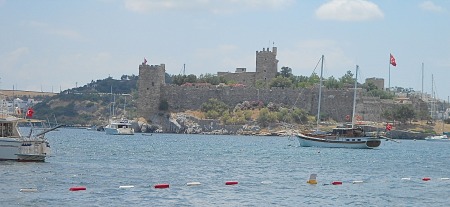 Castle of St Peter, Bodrum (Museum of Underwater Archaeology)
Castle of St Peter, Bodrum (Museum of Underwater Archaeology)
Pressed to name the very finest castle in Turkey I’d have to plump for the enormous one that looms over the harbour in Bodrum. Not only is this an impressive piece of multi-towered architecture but it has a fascinating story to tell as well since much of the masonry from which it was built was pilfered from the ruins of the Mausoleum of Halicarnassus, the great tomb of the Carian king Mausolus that had been one of the Seven Wonders of the Ancient World.
The castle was built in the early 15th century by the Christian Knights Hospitaller who wanted it to protect their holdings on the nearby island of Rhodes. They continued to reinforce it right up until 1522 when Sultan Süleyman the Magnificent seized both Rhodes and Bodrum and promptly built a mosque inside the castle.
The castle was restored in the 1960s. Since 1986 it has housed a museum of underwater archeology that is one of the best museums in Turkey. Highlights include the remains of the Uluburun, the earliest shipwreck ever excavated which is believed to have sunk as long ago as the 14th century BC, and the bones of a Carian princess whose features have been painstakingly reconstructed by experts from Manchester University. The views from the ramparts are spectacular. 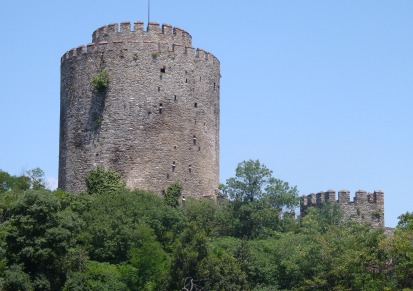
Even if your travels never take you further than İstanbul you can still visit one truly remarkable castle with a particularly venerable history and that is the “Fortress of Europe” that stands on the shores of the Bosphorus in the suburb named after it. Constructed in 1452, this was the castle that the Ottoman sultan Mehmed the Conqueror used as his base for the successful assault on Constantinople in 1453. It was built at the narrowest point on the strait immediately across from the older “Fortress of Asia” at Anadolu Hisarı, constructed by his great-grandfather, Beyazıt I, in 1394 as a base for his own unsuccessful assault on the city. Together the two castles enabled Mehmed to control traffic along the strait and so prevent food and reinforcements reaching the besieged Byzantines.
Rumeli Hisarı was restored in 1953 to celebrate the 500th anniversary of Mehmet’s achievement and again in the 2020s.
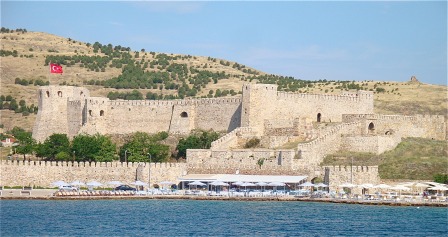 Bozcaada Castle
Bozcaada Castle
Just as the Castle of St Peter dominates Bodrum harbour so the magnificent castle at Bozcaada dominates the island’s much smaller harbour, greeting visitors as they step ashore from the ferry crossing. There the comparison ends though because this is a castle you can only normally admire from the outside except perhaps in the Turkish school holidays when the gates may reluctantly swing open.
The story of Bozcaada castle could be that of virtually any castle in Turkey with its origins trailing back to early Byzantine times. Later, first Venetian and then Genoese traders were permitted to reinforce it before finally in the 16th century the Ottomans moved in to make it their own. 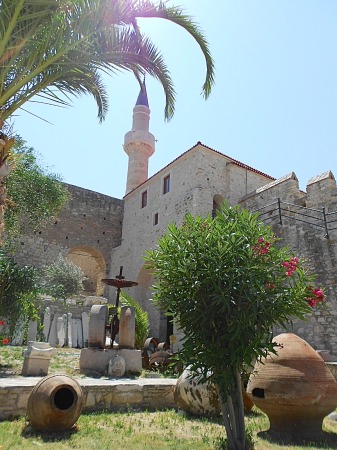
Çeşme Castle
Originally built by the Genoese, then rebuilt by Sultan Beyazıt II in 1508, the castle at Çeşme, beyond İzmir, also faces the harbour although its erstwhile dominance of its surroundings is not as obvious as in Bodrum or Bozcaada because it is more hemmed in by modern development. This is another castle that has been turned into a museum and as you wander round the ramparts admiring the views you will also be able to take a look at the finds from the archaeological site of Erythrae on the Karaburun Peninsula as well as at an exhibition devoted to the Ottoman-Russian War of 1768 to 1774 during the course of which almost the entire Ottoman fleet was destroyed off the coast of Çeşme.
The massive castle at Mamure is a splendid edifice with thirty-nine towers and a vast moat sitting right on the seashore east of Anamur on the Mediterranean coast. It owes its 13th-century origins to the rulers of the Armenian Kingdom of Cilicia although the site had probably been fortified since Roman times. In 1308 it was seized by the Karamanoğlu emir Mehmed Bey who stamped his mark on the building, in particular by adding a mosque to it.
Visitors to the seaside resort of Kızkalesi, near Silifke on the Mediterranean coast, can have the pleasure of sunbathing in the shadow of one enormous castle while gazing out over the sea to another smaller one, the Maiden’s Castle that gave its name to the town, standing in splendid isolation on an offshore island. Originally the two castles were linked by a causeway parts of which still survives underwater.
The Kızkalesi castles were originally the handiwork of the Byzantine emperor, Alexius I Komnenos, who had them built in the late 11th century as protection against the Crusaders. Needless to say, there’s a fanciful story about a princess marooned in the castle on the island for her own protection who is nonetheless killed by a bite from a snake delivered in a basket of fruit. Sound familiar? It’s the same story as is told about Kızkulesi (Maiden’s Tower) in İstanbul. 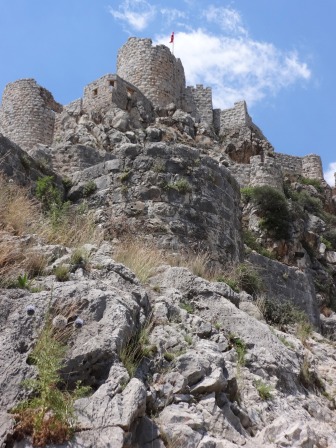
Heading north and east from Adana you move into what might well be branded Castle Country, with every hilltop bristling with fortifications. Right beside the main highway from Adana to Osmaniye you’ll see the impressive remains of Toprakakle (Earth Castle), dating back to the 13th century. Unfortunately the main road makes it hard to access this castle. Luckily the almost identical Yılankale (Snake Castle), just off the road to Kadirli, is much easier to get to with a road running right up to the castle.
Northeast of Adana, the forgotten town of Kozan was once Sis, the capital of the Armenian Kingdom of Cilicia. Here the rulers built a castle so high up on a craggy rock that it’s almost impossible to imagine how one is to get up to it let alone how it could ever have been built there. Fortunately a new road runs right up to the foot of the castle. To be honest, there’s not a great deal to see inside and climbing around in the ruins is potentially dangerous so you might want to save yourself the effort and just admire it in awe-struck wonder from a distance.
These days Gaziantep may be best known for the wonderful mosaics in the Zeugma Museum (and for its baklava, of course) but it also boasts another treasure in the shape of its magnificent castle, a cutdown version of the one in Aleppo, that stands on an artificial mound immediately behind the old bazaar. The site is thought to have been fortified since Roman times, with the Byzantine Emperor Justinian rebuilding a castle on the site. The Selçuks are thought to have constructed the current version with its monumental walls. You used to be able to go inside to visit the Panorama Museum celebrating the city’s fight against French occupation in 1920 but unfortunately in 2023 the castle fell victim to twin earthquakes. It may take years to recover.
These days many people visit Antep and admire its imposing castle. The same can hardly be said of Şebinkarahisar, a forgotten small town inland from Giresun on the Black Sea where an enormous castle with walls almost 1000 metres long straggles along a plateau high above the houses. By now you won’t be surprised to learn that it owes its genesis to Emperor Justinian; its ruinous condition is largely due to an earthquake of 1939. The castle was probably given its name – which means Alum Black Castle – to distinguish it from the Opium Black Castle (Afyonkarahisar) way over to the west.
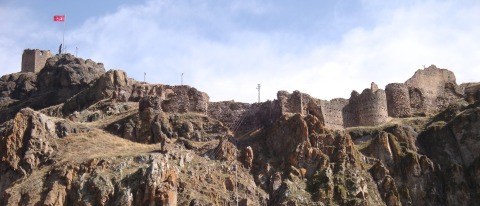
Also worth visiting: Hoşap Kalesi, Harput Kalesi, Afyonkarahisar, Silifke Kalesi, Softa Kalesi, Ardanuç Kalesi; the castles guarding the Dardanelles at Çanakkale and Kilibahir

